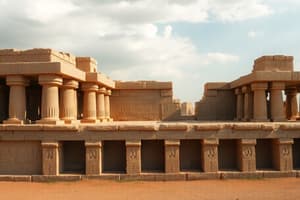Podcast
Questions and Answers
What type of bricks were used to construct the Ziggurat of Ur?
What type of bricks were used to construct the Ziggurat of Ur?
- Sunbaked bricks (correct)
- Baked clay bricks
- Fired bricks
- Baked mud bricks
What was the primary purpose of sailboats in Sumerian society?
What was the primary purpose of sailboats in Sumerian society?
- Transportation and trading (correct)
- Fishing and recreation
- Exploration and discovery
- Warfare and conquest
What was the initial purpose of the wheel in Sumerian society?
What was the initial purpose of the wheel in Sumerian society?
- Construction and architecture
- Warfare and defense
- Farm work and food processing (correct)
- Transportation and mobility
What was the primary benefit of the Sumerian irrigation system?
What was the primary benefit of the Sumerian irrigation system?
What was the function of the Ziggurat in Sumerian society?
What was the function of the Ziggurat in Sumerian society?
What was the purpose of the plow in Sumerian agriculture?
What was the purpose of the plow in Sumerian agriculture?
What innovation did the Sumerians develop to facilitate faster and easier travel?
What innovation did the Sumerians develop to facilitate faster and easier travel?
What did the farmer do with the seeds after the plow broke the ground?
What did the farmer do with the seeds after the plow broke the ground?
What was used to make the roads in ancient Sumeria?
What was used to make the roads in ancient Sumeria?
What did the Egyptians invent to make writing easier?
What did the Egyptians invent to make writing easier?
What was the Hanging Gardens of Babylon said to be made of?
What was the Hanging Gardens of Babylon said to be made of?
What was the problem with the clay tablets used by the Egyptians for writing?
What was the problem with the clay tablets used by the Egyptians for writing?
What was the primary purpose of watermills in agricultural processes?
What was the primary purpose of watermills in agricultural processes?
What was the Roman Empire considered to be in terms of politics and governance?
What was the Roman Empire considered to be in terms of politics and governance?
What was the outcome of the Roman Empire's large size and existing laws?
What was the outcome of the Roman Empire's large size and existing laws?
What is a modern-day application of watermills?
What is a modern-day application of watermills?
Why was the Roman Empire considered a strong political entity?
Why was the Roman Empire considered a strong political entity?
What was the result of the development of watermills in terms of food production?
What was the result of the development of watermills in terms of food production?
Study Notes
The Great Ziggurat of Ur
- Built using sun-baked bricks due to limited building materials
- Served as a sacred place for the chief god, accessible only to priests
Irrigation and Dikes
- Sumerians created dikes and irrigation canals to control flooding and bring water to farmlands
- Considered one of the world's most beneficial engineering works
Sail Boats
- Essential for transportation, trading, and fostering culture, information, and technology
- Enabled the discovery of faraway lands to settle and accommodate a growing population
The Wheel
- Invented in the latter part of Sumerian history, using specialized tools
- Initially used for farm work and food processing, not transportation
- Enabled mass production with the use of the wheel and axle
The Plow
- Invented to dig the earth faster and make farming easier
- Allowed farmers to sow seeds quickly and efficiently
Roads
- Developed to facilitate faster and easier travel
- Made using the same technology as sun-baked bricks, laid down on the ground
- Improved the flow of traffic and organization
Babylonian Civilization
- Emerged near the Tigris and Euphrates river
- Known for great builders, engineers, and architects
- Famous for the legendary Hanging Gardens of Babylon, although its existence is unconfirmed
Egyptian Civilization
- Located in North Africa, famous for its legacy
- Known for engineering feats, especially regarding infrastructures established by the Pharaohs
Paper or Papyrus
- Developed a system of writing, making it easier to handle and more durable than clay tablets
- Invented by Egyptians, resembling a more complex and accurate system
Water Mill
- Commonly used in agricultural processes, such as milling grains
- Enabled mass production of rice, cereals, and flours
- Also helped convert mechanical energy into electricity, leading to the invention of windmills and turbines
Roman Civilization
- Perceived as the strongest political and social entity in the west
- Known for its huge population, territory, and religious influence
- Considered the cradle of politics and governance during the period
- Served as a model for legislation and codified law, leading to the conquest of other civilizations
Studying That Suits You
Use AI to generate personalized quizzes and flashcards to suit your learning preferences.
Description
Test your knowledge of the ancient Sumerian civilization, including the construction of the Great Ziggurat of Ur and their innovative irrigation systems. Learn how the Sumerians built this monumental structure and how they developed ways to control flooding and bring water to their farmlands.




